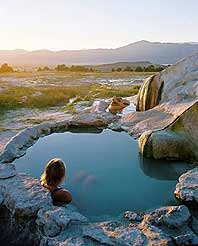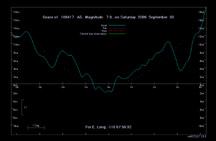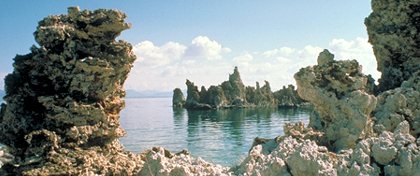

 For
this installment of the Astro 28 adventure, we're going to explore the connections
between plate tectonics, the formation of the inner planets, and how the geology
of California was shaped by these astronomical connections. And, we've chosen
the ideal location - the Eastern Sierra near Bridgeport, north of Mono Lake.
This region is rich in landforms of a volcanic past and present, and is in the
transition zone between three major geologic regions of the western hemisphere
- the Pacific Plate, the remnants of the Juan de Fuca Plate, and the Basin and
Range Province of the North America Plate. The grinding and subducting together
of these plates has bent, melted, stretched, and frictioned California into
the geologically amazing place that it is. Our interests in the Bridgeport area
are several - there's a grazing lunar
occultation of a star by the moon nearby this weekend, an occultation
by an asteroid, the skies are pitch black and crystal clear so we can study
the deep universe, and there are many primitive
hot springs in this
area which we can study and enjoy for our day-time lectures. Best
is Travertine Hot Springs. But Buckeye
Hot Spring is also excellent, pouring itself into a cold creek.
Fales Hot Creek was a favorite spot visited on our Astro
28C trip.
For
this installment of the Astro 28 adventure, we're going to explore the connections
between plate tectonics, the formation of the inner planets, and how the geology
of California was shaped by these astronomical connections. And, we've chosen
the ideal location - the Eastern Sierra near Bridgeport, north of Mono Lake.
This region is rich in landforms of a volcanic past and present, and is in the
transition zone between three major geologic regions of the western hemisphere
- the Pacific Plate, the remnants of the Juan de Fuca Plate, and the Basin and
Range Province of the North America Plate. The grinding and subducting together
of these plates has bent, melted, stretched, and frictioned California into
the geologically amazing place that it is. Our interests in the Bridgeport area
are several - there's a grazing lunar
occultation of a star by the moon nearby this weekend, an occultation
by an asteroid, the skies are pitch black and crystal clear so we can study
the deep universe, and there are many primitive
hot springs in this
area which we can study and enjoy for our day-time lectures. Best
is Travertine Hot Springs. But Buckeye
Hot Spring is also excellent, pouring itself into a cold creek.
Fales Hot Creek was a favorite spot visited on our Astro
28C trip.
 To
start, we have a grazing lunar occultation.
On Friday night at 8:10pm a magnitude 7.8 star grazes the southern limb of the
cresent moon. These beautiful and scientifically valuable events are only visible
along a very narrow track crossing the earth. For this event, the track
crosses quite close to our campground. Our camp is 2 km north of
the limit line, and we'll set up observers from along the road to our camp and
on to Twin Lakes. We will watch and record the 7th magnitude star as it disappears
and reappears behind the mountains and valley's on the edge of the dark side
of the moon. The profile of the edge of the
moon is quite rugged and promises a good show. Some notes on graze
station possibilities are linked here.
To
start, we have a grazing lunar occultation.
On Friday night at 8:10pm a magnitude 7.8 star grazes the southern limb of the
cresent moon. These beautiful and scientifically valuable events are only visible
along a very narrow track crossing the earth. For this event, the track
crosses quite close to our campground. Our camp is 2 km north of
the limit line, and we'll set up observers from along the road to our camp and
on to Twin Lakes. We will watch and record the 7th magnitude star as it disappears
and reappears behind the mountains and valley's on the edge of the dark side
of the moon. The profile of the edge of the
moon is quite rugged and promises a good show. Some notes on graze
station possibilities are linked here.
Early Sunday morning at 4:15am, the drama continues as the asteroid Arachne will occult an 11th magnitude star across a path described here. The predictions of these events still contains a bit of uncertainty, much more so than for lunar grazing occultations. But the path is well enough defined that our chances of actually seeing the occultation are very good. In fact, whether we see it or not, a solid observation will add valuable scientific information to the orbit and size of this asteroid. The path crosses astronomer-dense California and other occultation observers will likely be helping observe from the Bay Area and from Los Angeles, and also from Bishop south of us in the high Sierra. We'll videorecord the event, and I hope we can set out at least one other well-equipped station to record the event visually with a tape recorder and short-wave radio. My videorecording of course can be viewed by all, after the event.
Finally, a new comet - Comet Swan - will be a nice telescopic object 10 degrees up as dawn light first appears. It should be 7th magnitude.
 We'll
be exploring the active volcanic region which includes Mono Lake (left), the
massive Long Valley Caldera near Mammoth. The land here is rolling high plains
and
We'll
be exploring the active volcanic region which includes Mono Lake (left), the
massive Long Valley Caldera near Mammoth. The land here is rolling high plains
and  canyons
at roughly 6,000 ft elevation. It's home to aspen trees, pine, green meadows,
white water streams rushing down from the eastern slopes of the high Sierra,
and is a mecca for nature photographers. My good friend and professional photographer
Dave Wyman has annual pilgrimages to the area north of Mono Lake where we'll
be. You can see some of his photographs here.
Prime destinations will include Travertine Hot Springs (top of page)
and Buckeye Hot Springs (right), among
many geothermal springs and creeks in this area.
canyons
at roughly 6,000 ft elevation. It's home to aspen trees, pine, green meadows,
white water streams rushing down from the eastern slopes of the high Sierra,
and is a mecca for nature photographers. My good friend and professional photographer
Dave Wyman has annual pilgrimages to the area north of Mono Lake where we'll
be. You can see some of his photographs here.
Prime destinations will include Travertine Hot Springs (top of page)
and Buckeye Hot Springs (right), among
many geothermal springs and creeks in this area.
Arrive by 6pm in order to claim a plot of land and set out your tent, and prepare for the graze.
8:00pm - Grazing occultation happens.
8:45pm - Dinner. Followed by dark sky explorations, weather permitting. Otherwise, campfire lectures and comradery.
8:15am I'll begin preparing the French Crepes. Probably be 9:15am before they're ready to start coming off the griddle's.
10:30am - head out and do our day explorations. Travertine Hot Springs, Buckeye Hot Springs, and Fales Hot Creek. Possible trip to Bodie if we have time and interest.
5:45pm - Re-convene at camp and start dinner
7:45pm - at the scopes. Study the moon, wonders of the summer Milky Way. Campfire lectures.
8:30am - start breakfast preparations. Veges and fresh potato hash browns spiced with cumin and curry powder. Fresh fruit complement.
9:30 - pack up camp, and head out. Rendezvous at Mono Lake Visitor Center for lecture on Basin/Range geology and relation to inner planets surface processes. Optional stop at the Obsidean formations a few miles away, or the tufa towers at South Beach. Then, we say our goodbye's and head back up to Yosemite and home.
Topographic Maps , Weather, Checklist, and On-Line Handouts
Link here to a map of Bridgeport and Travertine Hot Springs. And here for a map of our campground - Honeymoon Flat Campground. One of our graze stations will be at the campground. Here's a link to ClearSkyClocks for the astronomically relevant weather forecast for Bridgeport for each of the next 48 hours. And here's a Camper's Checklist. Finally, here's an on-line version of the geology handout
Trip was another big success! Check out the Post Trip Photo Page